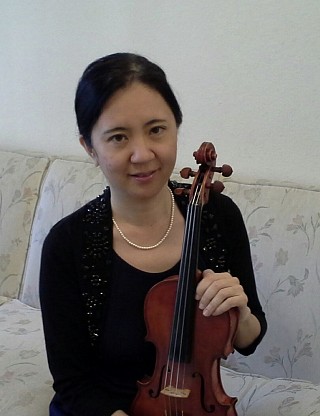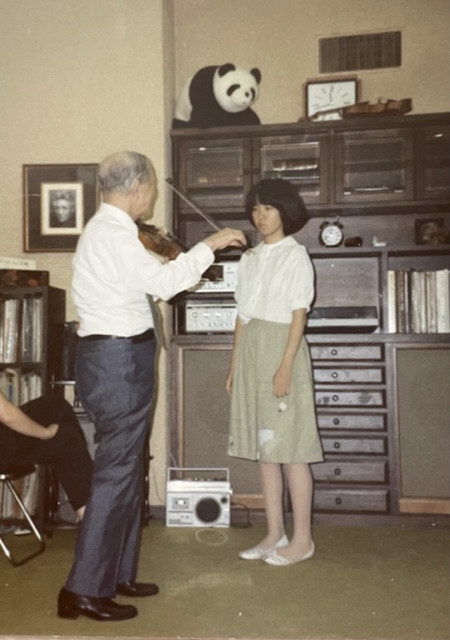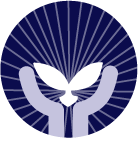Chizu Kataoka

Studying with Dr. Suzuki opened my eyes to the scope and depth of the world of music and helped me to decide that I want to continue pursuing music in college. After four years in Japan, I attended Indiana University. I studied with Professor Josef Gingold and the concert violinist Yuval Yaron and received my Bachelor of Music in violin performance. During this time, I served as assistant teacher to Yuval Yaron and started teaching my first private students. I went to Manhattan School of Music in New York City for my Master of Music in violin performance, studying with Mr. Mitchell Stern. I was on the faculty of the Manhattan School of Music Preparatory Division, teaching Suzuki violin, viola, and chamber music.
Later I was the Associate Concertmaster of the Midland-Odessa Symphony and a full-time Suzuki teacher at the Milam Fine Arts Magnet School in Odessa, Texas. I was Director for the Suzuki Summer Institute in Hobbs, Texas, and lecturer/chamber music/violin coach at the Heart of Texas Institute. Then I got married, and my husband, Quan Jiang, became Assistant Concertmaster of the San Antonio Symphony and I was a member of the first violin section of the Austin Symphony. We performed in a monthly chamber music series and had private studios, mainly teaching students in the home school community. Then Quan won a position with the Houston Symphony. Our daughter was born, and she grew up as a Suzuki student, studying both the violin and cello. She currently attends college! We go to Japan to perform and to teach at my parents’ music camp every summer, and we enjoy reading chamber music with our extended family.
Other Places you have lived since Japan: Bloomington, Indiana; New York city; San Antonio, Odessa, Houston Texas
Instruments studied in Japan: violin and cello
Dates in Japan: I was in Matsumoto to study with Dr. Suzuki from 1984-1988. During this time, I studied the violin and cello as a kenkyusei, and was the youngest student to graduate from the Talent Education Institute. I was chosen by Dr. Suzuki to perform as a soloist in violin and cello for the Suzuki Ten Children’s Concert Tour for three years (1986-1988). For this tour, each October we performed in 15 cities throughout the US and three or four cities in Japan. I came to realize how much the Suzuki Method had influenced so many people throughout the world and how important Dr. Suzuki’s work was through seeing the hundreds of students at workshops and concerts on these tours.
Years and locations of workshops with Dr. Suzuki that were outside of Japan: I participated in the International Suzuki Conference and Summer School in Matsumoto. As a student of Dr. Suzuki, I attended and performed solo and chamber music at the International Suzuki Conference in Berlin, the Teacher’s Conference in Chicago, and Summer School in Matsumoto.
Memories
My mother, Eiko Kataoka (maiden name Suzuki) started the violin as one of the first Suzuki Method students in Japan at the age of three. She studied with Mr. Tomio Kondo and Dr. Suzuki and became one of the first violin teachers that Dr. Suzuki sent to America to introduce the Suzuki Method. She taught in Westchester, New York, and then attended Oberlin college. Both she and her husband, cellist Masayoshi Kataoka, were longtime members of the St. Louis Symphony and had their own Suzuki studio. After finding the need for English translations of Dr. Suzuki’s writings for their students, they founded the Talent Education Journal which later became the International Suzuki Journal.
I grew up as a Suzuki student, starting the violin at age 3 with my mother, and the cello with my father when I was 8. Before going to Japan, I practiced the violin and cello as a part of my everyday routine. As a young child, I attended the Summer School in Japan on a few occasions. I remember that Dr. Suzuki always talked to children at their eye level. I remember the joy of playing pieces with a stage full of students. It was a thrilling feeling. I realized that even though we were all from different parts of the world, we could all play music together.
When I was 14 years old, my parents decided to send me to Japan to study with Dr. Suzuki. I was a kenkyusei for four years. My younger sister joined me there as well.
I rented a room in a house with two or three other students in Satoyamabe. The landlady cooked breakfast and dinner every day. During my last two years I moved to an apartment (Tanaka Apartments) by the river, closer to the Kaikan.
The surrounding mountains were beautiful! Like most kenkyusei, I used to ride my bicycle everywhere with my violin case strapped to my back. The winters were very cold, and I remember putting the kettle on top of my kerosene heater so the steam would warm the room.
The kenkyusei were assigned to weekly lessons in groups. Our lessons always started with tone production exercises. We would ask another student listening to write comments in our music. I remember looking forward to reading suggestions from other students. I still have the music today.
For kenkyusei group classes, I remember the green chairs in neat lines and having to go up to the front stage to play a few measures of Judas Maccabeus to see how many puddings we would receive for good tone! And during the day, the kenkyusei room was always filled with people practicing various pieces all at once. Before group class started at 9 AM when Dr. Suzuki arrived, he would greet each one of us with a big smile and a “good morning!” His love and enthusiasm were contagious. Cookie time happened a few times every day. I remember Dr. Suzuki giving us 10,000 yen to go to the store to replenish the weekly cookie supply.
I was a member of the Suzuki Ten Children’s Tour from 1984-88. Dr. Suzuki chose ten students to perform in fifteen cities in the US each October. I played solos on the violin and cello, and as a group we played pieces like the Mendelssohn Concerto 3rd movement, Scherzo Tarantella and Ave Maria. I remember meeting so many wonderful families, students, and teachers of the Suzuki family. It was especially memorable to be able to stay with host families in each city: to be a part of their lives for two days, share meals with them, and play Suzuki pieces together after dinner. Once we stayed in a home with five kids. The parents cooked delicious Thai food for dinner. In Miami we stayed with a couple who had a big indoor pool. In Mesa, Arizona, we were fascinated by the masks decorating the walls. Playing concerts and workshops, I realized the amazing power of the Suzuki Method, the fact that all of us are connected through music even though we are all from different backgrounds. This experience made me want to continue spreading Dr. Suzuki’s love to as many people as possible throughout my life!
Photos in Japan

Students and teachers of the 1997 Suzuki Ten Children’s Concert Tour with Dr. Suzuki

Lesson with Dr. Suzuki

Lesson with Dr. Suzuki

